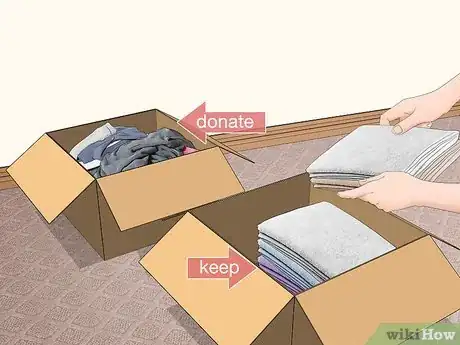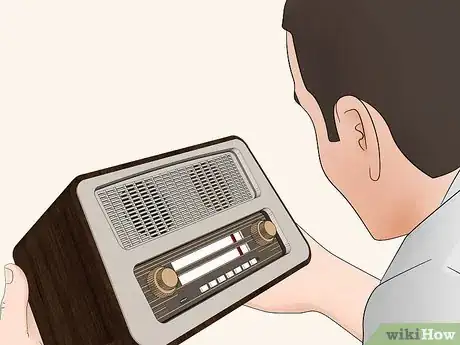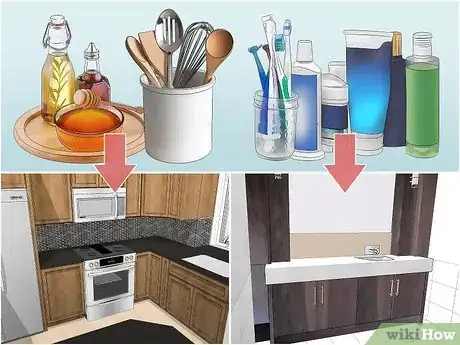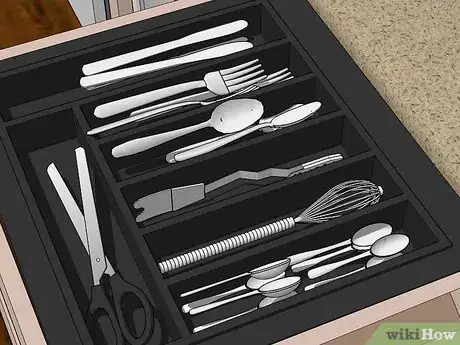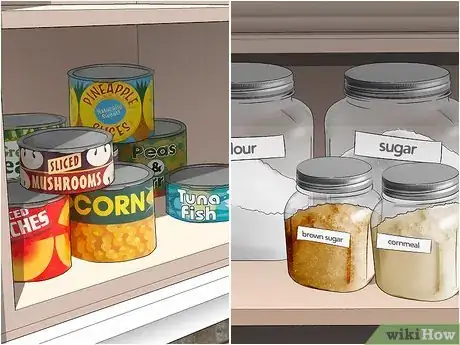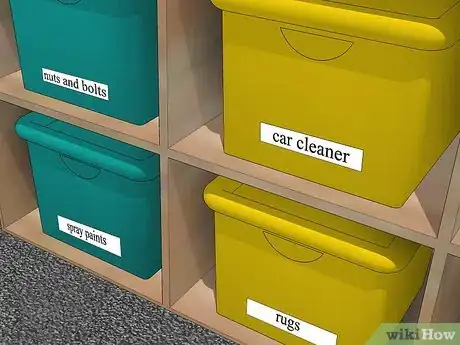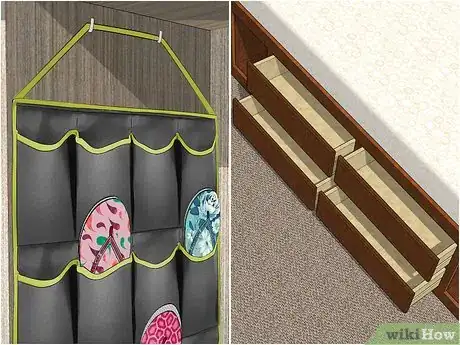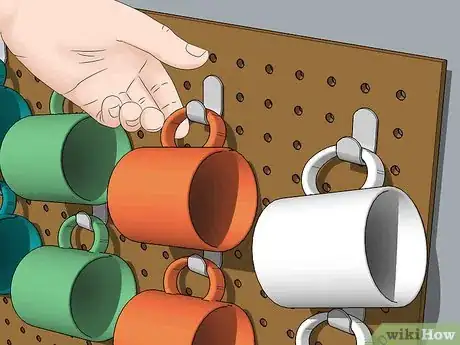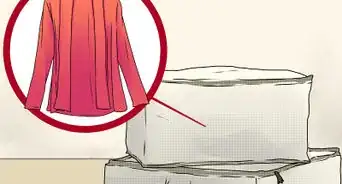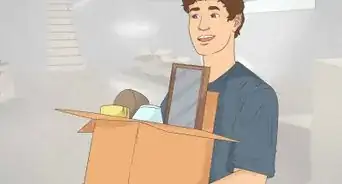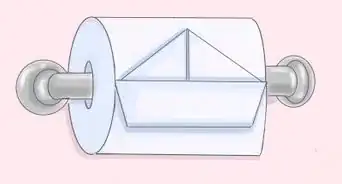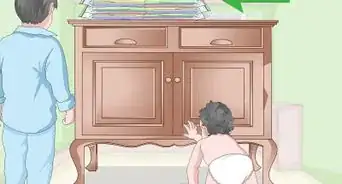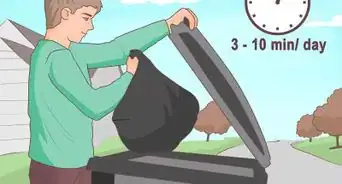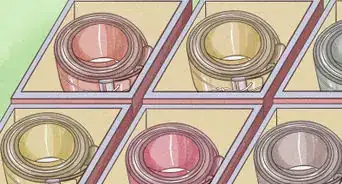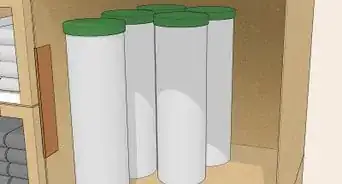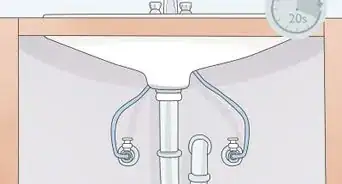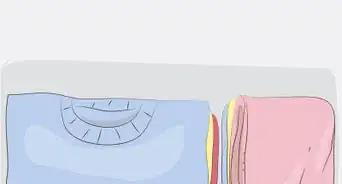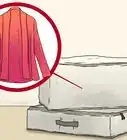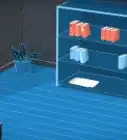This article was co-authored by Marty Stevens-Heebner, SMM-C, CPO®. Marty Stevens-Heebner is a Certified Professional Organizer (CPO) and Founder of Clear Home Solutions, a home organizing and senior moving management company based in southern California. Marty is the first Certified Senior Move Manager (SMM-C) in the United States and is a Certified Aging in Place Specialist (CAPS) through the National Association of Home Builders. She is the President-Elect and is on the board of directors of the National Association for Senior Move Managers, a member of the National Association of Professional Organizers, and has been acknowledged as a Hoarding Specialist and ADHD Specialist through the Institute for Challenging Disorganization.
wikiHow marks an article as reader-approved once it receives enough positive feedback. In this case, 100% of readers who voted found the article helpful, earning it our reader-approved status.
This article has been viewed 262,634 times.
Is clutter driving you crazy? An organized lifestyle can mean efficiency in your day and a more relaxing time while at home. Your home will look cleaner and you will find that you have more space which is easier to use and enjoy. Follow the tips below to begin organizing your home.
Steps
Getting Rid of Unnecessary Items
-
1Sort your items. Go through every room in your home and sort items by what you will do with them: keep, donate, or throw away. Keep items should be things you need and cannot part with, throw away items should be those which are completely useless to everyone, and donate items are those which you can’t use but someone else would benefit from.[1]
-
2Think critically about ‘keep’ items. Sometimes we feel like we need something but we really don’t. These are the types of items which usually make homes cluttered and leave little space for the things we do need. Once you’re done with the initial keep-donate-trash sweep, make a second sweep through your keep items and think about the last time you used them and if you actually need them.[2]Advertisement
-
3Find good uses for non-keep items. For the items that you will trash or donate, consider the best uses for those items. Certain types of donated items will do the most good if donated to particular organizations (old furniture to Goodwill, toys to the Salvation Army, clothes to refugee organizations, etc). Make sure that items you designate trash really are trash. Tattered clothing should not be donated but low-quality though functional and intact kitchen equipment could really help someone out.
Separating Items by Room and Function
-
1Sort items by function. Go through all of your keep items and decide what their primary function is. Like items should be grouped together so that you can decide how best to store them. They may be able to nest inside each other or otherwise be stored together efficiently. If they don’t really have a function, you may want to consider putting them in the donate pile.[3]
-
2Sort items by room and location. Once your items are sorted by function, separate and organize them by what room is appropriate for them to go in. Think about their function and locate them where they can be efficiently reached and used. Though items may share a similar function, they may need to be split up if one serves its purpose better elsewhere.
- For example, kitchen supplies should be kept in the area of the kitchen where they can be easily accessed when necessary. Items which are not used often can be stored up and out of the way, like infrequently used appliances (such as ice cream makers) or fancy or overly large dishes.
-
3Consider multiple purpose items. Consider items which serve multiple purposes and find a place to store them where both can be served without hindering the other. In some cases, you have multiples of that item, you can split them up between locations but this may not always be possible.
- An example of such an item may be small towels, which may be necessary to both the bathroom and the kitchen.
Using Storage Solutions
-
1Have a home for every item. Items left lying around will make your home look cluttered and unorganized so be sure to have a home set aside for every item. A good practice is to stand in a room and pick up every visible item and ask yourself if that is where that item should be at all times. If it’s not, find a place for it to go.[4]
- You will especially want a set home for items like your keys, phone and wallet. Keep a set spot for them near the door and develop a habit of always putting them in that spot. Doing this will keep you from constantly misplacing your items.
-
2Store items efficiently. Store items in a way which minimizes the amount of space they take while maximising how much use you can get out of them. With items organized efficiently, your home will have more space and look less cluttered.
- Small items in a ‘junk’ drawer can be sorted into labeled used Altoids tins, for example (to keep them from getting mixed up and wandering everywhere).
- Tension rods can be placed in a tupperware drawer to hold back and separate lids.
- Place metal sheets on the inside of cupboards so that you can use that space to store recipe clippings, instead of attaching them to your fridge.
- Organize necklaces on coat hooks, earrings in ice cube trays, and purses on hangers.
- Those plastic compartments, fishing or tool bins can be really handy for all kinds of miniatures like watches, fuses, cosmetic supplies, batteries, or accessories of many sorts.
- Put stock cooking ingredients (like sugar and flour) into tins or mason jars, to make them stackable and easier to store. Put spices into metal spice tins and store them on the side of your fridge.
- Use a filing cabinet to store laundry supplies and a shoe organizer on the inside of cabinet doors to store kitchen cleaning supplies.
-
3Create storage systems. For items of which you have multiples or large numbers, you will want to instigate a system of organization to help you find the individual items when needed. This will also help you use less space to store them to begin with, allowing for more storage space.
- Get a filing cabinet or filing boxes for files and papers. This is especially important for crucial documents like tax papers, birth certificates, and other sensitive information which you may need to find in a hurry or do not want to get lost.
- Have a set system for your clothes. You will have to devise a system which works best for you, but be sure you have a clear way of organizing both clean and dirty clothes. Dirty clothes can be separated by color into different baskets. Clean clothes should be hung neatly when needed and otherwise stored in drawers or baskets. Take a cue from frequent fliers and roll your clothes when storing them in drawers to minimize wrinkles and maximize storage space.
-
4Think about using wasted space. Think about spaces which go unused and how they may be turned into good storage space. Finding ways to use the extra space in your home will maximize your organizational options.
- A cubby space between a fridge and a wall could be home to a pull-out shelving unit for small items like cans and jars.
- An awkward spot in a hallway could be home to a small bookshelf and used for various items.
- The space under your bed can be used to store off-season bedding and large coats and sweaters (using boxes, bags, or roll-out storage).
- Think about vertical space. It's often a missed opportunity and can really give excellent solutions. That empty void between the clothes and the closet floor can be filled with shelves or hanging shoe, belt or tie racks. Many people purchase units that can hold tools, bikes, anything up against the wall. Just don't but things to high up
Developing Good Habits
-
1Consider each new item you buy. Staying organized is about developing better habits. One good habit to develop is analyzing each new item you buy or otherwise acquire. Don’t build up a whole bunch of things you don’t need. This will make your home cluttered and disorganized all over again. Remember for that each item you acquire, you will have to find a home for it.[5]
-
2Put things where they go. Get in the habit of always putting things away when you are done using them. Don’t tell yourself you’ll get it later or that maybe someone else will need to use it: just put it away. This habit will go the furthest in ensuring that your home stays organized.
-
3Make ‘giving away’ a regular habit. Always have a bag or box in your house which is a designated ‘donate’ location. Put items in there that you find you don’t use anymore and try to put one or two items in every time you acquire a new item.
Expert Q&A
Did you know you can get expert answers for this article?
Unlock expert answers by supporting wikiHow
-
QuestionWhere do I start decluttering my house?
 Marty Stevens-Heebner, SMM-C, CPO®Marty Stevens-Heebner is a Certified Professional Organizer (CPO) and Founder of Clear Home Solutions, a home organizing and senior moving management company based in southern California. Marty is the first Certified Senior Move Manager (SMM-C) in the United States and is a Certified Aging in Place Specialist (CAPS) through the National Association of Home Builders. She is the President-Elect and is on the board of directors of the National Association for Senior Move Managers, a member of the National Association of Professional Organizers, and has been acknowledged as a Hoarding Specialist and ADHD Specialist through the Institute for Challenging Disorganization.
Marty Stevens-Heebner, SMM-C, CPO®Marty Stevens-Heebner is a Certified Professional Organizer (CPO) and Founder of Clear Home Solutions, a home organizing and senior moving management company based in southern California. Marty is the first Certified Senior Move Manager (SMM-C) in the United States and is a Certified Aging in Place Specialist (CAPS) through the National Association of Home Builders. She is the President-Elect and is on the board of directors of the National Association for Senior Move Managers, a member of the National Association of Professional Organizers, and has been acknowledged as a Hoarding Specialist and ADHD Specialist through the Institute for Challenging Disorganization.
Certified Professional Organizer & Senior Move Manager Certified Professional Organizer & Senior Move ManagerExpert AnswerInstead of thinking you have to organize your whole home at once, break it into simpler tasks. For example, start by writing down the 3 biggest problem areas in your home. Then, write down the 3 specific places in each space where clutter tends to accumulate, like your coffee table, countertop, or junk drawer.
Certified Professional Organizer & Senior Move ManagerExpert AnswerInstead of thinking you have to organize your whole home at once, break it into simpler tasks. For example, start by writing down the 3 biggest problem areas in your home. Then, write down the 3 specific places in each space where clutter tends to accumulate, like your coffee table, countertop, or junk drawer. -
QuestionHow do you declutter when overwhelmed?
 Marty Stevens-Heebner, SMM-C, CPO®Marty Stevens-Heebner is a Certified Professional Organizer (CPO) and Founder of Clear Home Solutions, a home organizing and senior moving management company based in southern California. Marty is the first Certified Senior Move Manager (SMM-C) in the United States and is a Certified Aging in Place Specialist (CAPS) through the National Association of Home Builders. She is the President-Elect and is on the board of directors of the National Association for Senior Move Managers, a member of the National Association of Professional Organizers, and has been acknowledged as a Hoarding Specialist and ADHD Specialist through the Institute for Challenging Disorganization.
Marty Stevens-Heebner, SMM-C, CPO®Marty Stevens-Heebner is a Certified Professional Organizer (CPO) and Founder of Clear Home Solutions, a home organizing and senior moving management company based in southern California. Marty is the first Certified Senior Move Manager (SMM-C) in the United States and is a Certified Aging in Place Specialist (CAPS) through the National Association of Home Builders. She is the President-Elect and is on the board of directors of the National Association for Senior Move Managers, a member of the National Association of Professional Organizers, and has been acknowledged as a Hoarding Specialist and ADHD Specialist through the Institute for Challenging Disorganization.
Certified Professional Organizer & Senior Move Manager Certified Professional Organizer & Senior Move ManagerExpert AnswerTake it one step at a time. Break down the organizing process into small, manageable tasks. Then, schedule a time for each task. Write in your calendar that you're going to do a certain task at a certain time. For instance, you might write that at 1:00 p.m. on Saturday, you're going to clean out your junk drawer for an hour. If you're feeling overwhelmed, you can even schedule 20 minutes at a time.
Certified Professional Organizer & Senior Move ManagerExpert AnswerTake it one step at a time. Break down the organizing process into small, manageable tasks. Then, schedule a time for each task. Write in your calendar that you're going to do a certain task at a certain time. For instance, you might write that at 1:00 p.m. on Saturday, you're going to clean out your junk drawer for an hour. If you're feeling overwhelmed, you can even schedule 20 minutes at a time. -
QuestionShould I clean or declutter first?
 Marty Stevens-Heebner, SMM-C, CPO®Marty Stevens-Heebner is a Certified Professional Organizer (CPO) and Founder of Clear Home Solutions, a home organizing and senior moving management company based in southern California. Marty is the first Certified Senior Move Manager (SMM-C) in the United States and is a Certified Aging in Place Specialist (CAPS) through the National Association of Home Builders. She is the President-Elect and is on the board of directors of the National Association for Senior Move Managers, a member of the National Association of Professional Organizers, and has been acknowledged as a Hoarding Specialist and ADHD Specialist through the Institute for Challenging Disorganization.
Marty Stevens-Heebner, SMM-C, CPO®Marty Stevens-Heebner is a Certified Professional Organizer (CPO) and Founder of Clear Home Solutions, a home organizing and senior moving management company based in southern California. Marty is the first Certified Senior Move Manager (SMM-C) in the United States and is a Certified Aging in Place Specialist (CAPS) through the National Association of Home Builders. She is the President-Elect and is on the board of directors of the National Association for Senior Move Managers, a member of the National Association of Professional Organizers, and has been acknowledged as a Hoarding Specialist and ADHD Specialist through the Institute for Challenging Disorganization.
Certified Professional Organizer & Senior Move Manager Certified Professional Organizer & Senior Move ManagerExpert AnswerYou can actually do both at once. Make a list of areas to organize and schedule a time to do each one. During your scheduled time, clean each area thoroughly. Go through every item in the area you're organizing and decide what to keep. Get rid of anything that you don't need and anything you have duplicates of. When you find things in that area that belong elsewhere, put them all in one place, then pick them up once you're done. That way, you won't lose focus.
Certified Professional Organizer & Senior Move ManagerExpert AnswerYou can actually do both at once. Make a list of areas to organize and schedule a time to do each one. During your scheduled time, clean each area thoroughly. Go through every item in the area you're organizing and decide what to keep. Get rid of anything that you don't need and anything you have duplicates of. When you find things in that area that belong elsewhere, put them all in one place, then pick them up once you're done. That way, you won't lose focus.
Warnings
- Be careful when moving furniture. Lift with your legs, not your back, and ask a friend to help you.⧼thumbs_response⧽
- Keep in mind fire hazards while you are organizing. Some safety hazards include overloading a wall outlet with extension cords, storing huge stacks of newspapers, or not putting away shoes and other articles that block your exit path in an emergency.⧼thumbs_response⧽
References
- ↑ https://justagirlandherblog.com/how-to-organize-every-space-in-your-house/
- ↑ https://www.lifehack.org/articles/featured/how-to-organize-your-home.html
- ↑ https://justagirlandherblog.com/how-to-organize-every-space-in-your-house/
- ↑ https://lambertslately.com/2018/04/ten-simple-ways-to-start-organizing-your-home.html
- ↑ https://www.womansday.com/home/organizing-cleaning/g2801/life-changing-organization-tips/
About This Article
To organize your home, start by going through every room in your house and sorting items by what you will keep, donate, or throw away. Next, get rid of the items you don’t need by donating them to charity if they are still useable and if not, throw away or recycle them. Then, create storage systems for each group of items such as placing necklaces on coat hooks, earrings in ice cube trays, and purses on hangers. Additionally, consider getting a filing cabinet or filing boxes to store important files and papers. For more tips, like how to create a system for clothes, keep reading!
